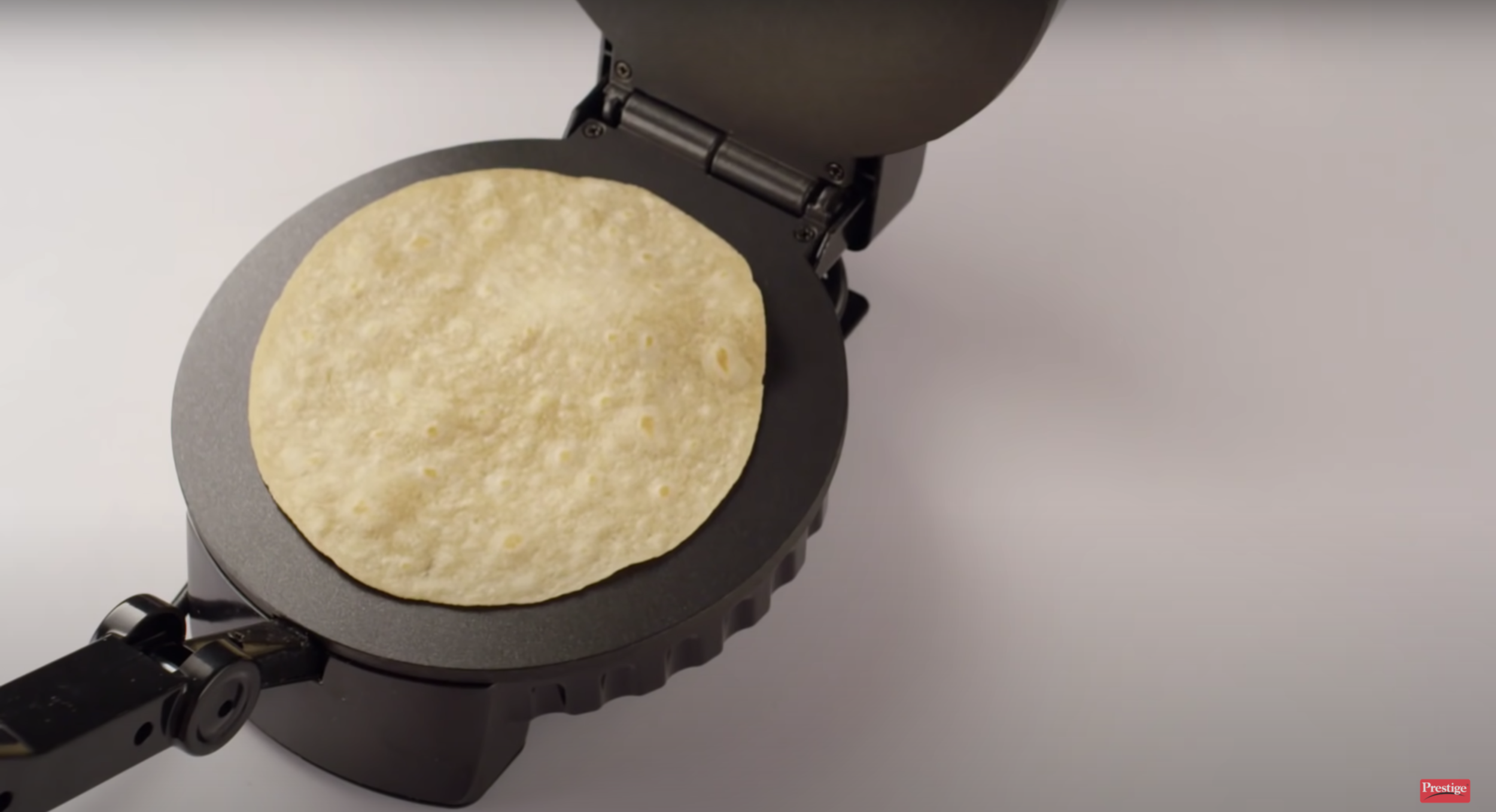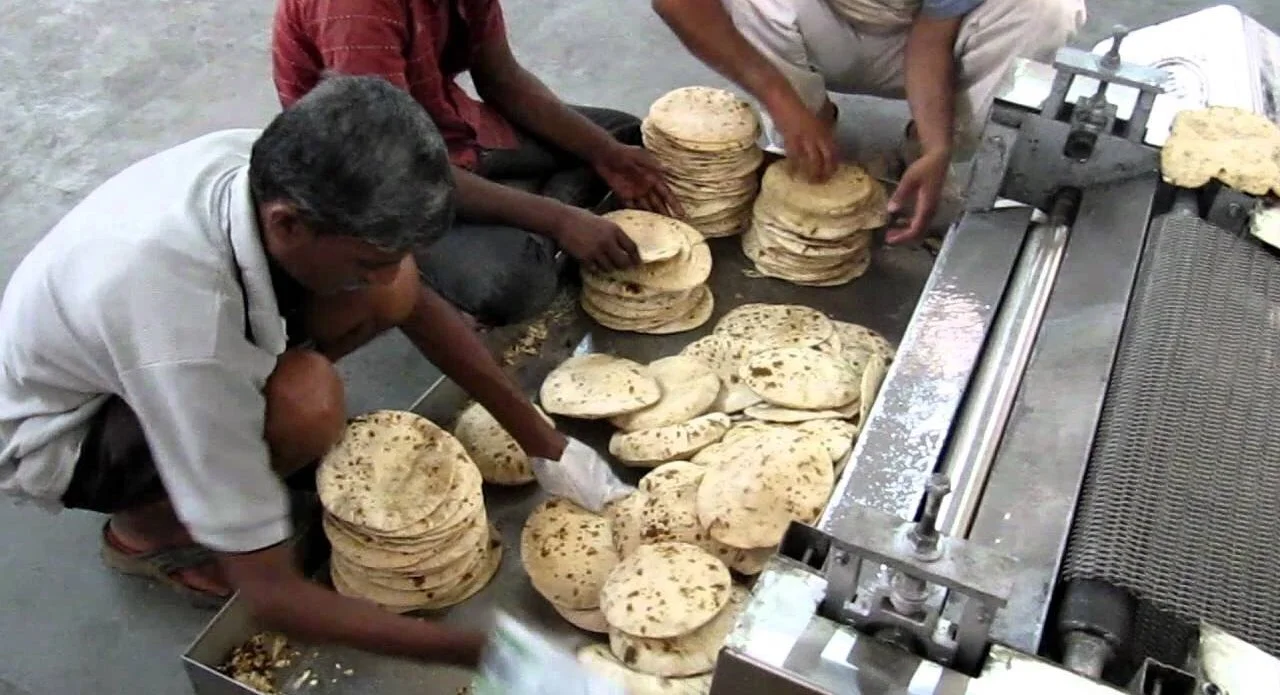The Failure of the Great Indian Roti Maker

Despite its promise of efficiency, the appliance must compete with the roti’s powerful cultural significance to become a kitchen fixture. Sneha Mehta looks at the conflict between ‘masculine’ appliances and ‘maternal’ meals.
For a country like India, with over a billion people and almost as many cultural and culinary traditions, to have a single national staple food is incredible. But the humble roti beats every other item by a stretch. In India, and the subcontinent at large, most people eat rotis every day, if not with every meal.
Also known as chapatti, phulka, or rotli, this familiar disc is the perfect vessel for vegetables, dal, and pickles, or eaten plain with raw onions, chillies and salt. While scarfing down hot rotis can take only a matter of minutes, making them by hand is hard work — the perfect shape, softness and char comes with years of practice, taken on mostly by women from a very young age, and therefore becoming irreversibly linked to ideas of motherhood. Rotis feed the nation’s appetite and its imagination.
But while a handmade, hot, ghee-topped roti is a powerful memory trigger, India’s burgeoning young, urban middle class are captivated by the promise of consumer appliances to simplify household chores. Smart young inventors from engineering colleges, or with no formal education, seem to be constantly applying their skills to solving the roti-making process through automation and even AI, with the premise: if we all eat rotis, and they’re notoriously labor-intensive to make, why shouldn’t a machine do the job faster and cheaper?
The Roti-Making Process Made Easy
Making rotis is a three-step job. While rotis are made in a range of flours such as bajra, jowar, buckwheat and mazie, the Green Revolution in the 1960s ensured that wheat flour became most commonly associated with the roti. But despite these regional variants, the fundamental process is the same everywhere. Water and atta are kneaded together to make an elastic, pliable dough, which is broken up into small balls and rolled into flat circles using a belan and a chakla. These dough discs are then cooked on a tawa, and at the last minute transferred to an open flame to puff up, giving them the name phulka. Making rotis is not a science, but a skill that needs patience, and is learned by intuition, literally feeling one’s way through the steps. The more you do it, the better you become.
The Prestige Roti Maker
Fully automatic commerical roti maker
The Rotimatic
Commercial roti maker
A typical household electric roti-maker on the other hand, requires only one of the above steps: making the dough. The device takes about five minutes to heat up, and the heating light switches off once it is ready to use. The dough ball, rolled in a little dry flour, can then be placed in the centre of the Teflon-coated base of the roti maker. The lid — which resembles a tortilla press in shape — should then be pressed for two seconds. In theory, less than a minute later, the roti should be cooked. Popular brands like Prestige manufacture this product; Bajaj calls its version the ‘Go-Ezzee.’ A roti-maker from any brand typically costs between Rs 2,000-3,000.
“My mother bought a roti-maker in the 90s,” said Sabeena Uthaman, a school librarian based in Chennai. “We thought it’ll make our jobs easier than getting out the rolling pin, flour, and the other things, which is a little messy. For the roti-maker, you only need the dough. I found it a really handy thing.”
Roti-Maker to the Rescue
Roti-makers have existed in the market for a long time, but the coronavirus pandemic caused an explosion in demand. For working women faced with the prospect of feeding a family without household help during the lockdown, a roti-maker seemed like a saviour from the labour of making fresh rotis to order. For students and young working professionals living away from home, the device promises to replicate the experience of eating mum’s cooking.
And for organisations trying to help the underprivileged, like India’s stranded migrant workers or other poor communities — some reports claim that 190 million people suffered from malnutrition and hunger in India in 2019 — industrial-sized roti-making machines which can pop out 1,000 rotis an hour seem almost a magical invention. NGOs and community organisations across the country use machines of this sort, as does the Golden Temple in Amritsar, for its legendary langar which can feed up to one lakh devotees a day. When it comes to India and the roti, automation — the product of the second industrial revolution — serves two very disparate audiences.
The Downside of Roti Makers
Indians have a tendency to attribute a certain exaggerated power to machines. People buy the roti-maker’s seductive promise of efficiency, but most users report that the device is clunky and difficult to use, and the actual taste of the roti just isn’t very good. Or more simply, it doesn’t taste like home.
“I distinctly recall practicing on it [roti-maker] quite diligently, and while it did press the dough into rounds, it was definitely not perfect,” said Amrita Amesur, a food writer based in Mumbai, who is an outspoken critic of traditional gender roles in the kitchen. “And ultimately we found that it really was not close enough to the rotis we were used to eating, made on a flame or a hot tawa. It felt kind of useless after the initial fascination wore off.”
If the dough isn’t made perfectly — it must be wetter than usual — the rotis made in the machine can be rubbery, dry, and thicker than the ones that are made by hand. And so the disappointing product is quickly discarded and left to gather dust in the back of a cupboard. Yet for nearly 30 years, roti-makers have hardly changed in terms of design and functionality. It seems like common sense that if a product isn’t working the way it should, the manufacturers should prioritise its improvement. But Ashish Jain, Design Lead at the Centre for Innovation, L V Prasad Eye Institute in Hyderabad, claims that this common sense doesn’t always align with the economics of innovation.
“Why do people buy things? It’s marketing,” said Jain. “The product might not work, but once bought, the only thing they can do is use it or throw it away. Consumer products are so slow in terms of innovation because they work on incremental innovation. This means that the manufacturer makes minor changes and continues to sell the product because it generates regular revenue and keeps the market engaged. It is to nobody’s advantage to make a perfect product.”
Less Effort, More Efficient
For business-owners, the taste of the roti is secondary to the time, money and manpower the machine can save them. Madhvi Mehta runs a business called Paratha Basket in Pune, and makes parathas and theplas; her clients are typically travellers and students going abroad. She makes abound 300 parathas in a day manually, with the help of three employees. But she found that apart from being physically gruelling, most of her time was spent managing the employees. So earlier this year she travelled to Rajkot to buy a semi-automatic roti-making machine from Fortune Engineering, a leading manufacturer of the device, for around Rs 75,000. The machine fits in her balcony at home, makes about 500-700 parathas in an hour, and even though she has to make the dough herself, Mehta is all praise for it.
“The increased turnover means that I can really expand my business,” said Mehta. “As for the taste, it is like comparing fabric made on a handloom to that from a power loom. There are definitely differences, but it’s wrong to compare, because the output is not meant to be identical.”
There are even more innovative products in the market. Mukunda Foods, a startup based in Bengaluru makes a product called the Doughbot which is fully automatic. A startup in Singapore founded by two Indian expats produces the Rotimatic, which uses Artificial Intelligence and advanced algorithms, and can be controlled over WiFi to make everything from the dough to the roti, for the hefty price of $999.
The Novelty of Hand-Made Rotis
But despite the different kinds of roti-makers in the market, the cultural significance of hand-making a perfectly round roti has never waned, and it is a burden carried only by women. “We buy the vacuum; we consume assumptions about gender, households, families, and social status,” writes anthropologist Nathan Greenslit, in an essay in the book Evocative Objects. Like the vacuum, the roti-maker then becomes part of a larger social order, and can actually strengthen the existing gender norms; its usage can signify a woman’s inability to make round rotis.
“Last year, I made around 40-50 puris for a function, fairly well and round. I felt my father acknowledge and appreciate my ability in a way that he never has with any of my other achievements,” said Amesur. “When I learned to cook I felt like I could take care of myself, but the feeling my father had, was that I can finally take care of a husband with my round puris.”
Amesur’s experience is a universal one. The roundness of a woman’s roti is a marker of her domestic competence, while men are applauded for rolling out even a misshapen “map of India.” Consumer appliances like the roti-maker pit the efficient masculinity of the machine against the imperfect femininity of women’s labor. Our shared associations between handmade rotis and maternal love are so mythicised in popular culture, that more often than not, the machine disappoints us emotionally, not functionally.
In fact, the failure of the roti-maker to produce great tasting rotis can confirm the belief held by many that a woman’s place is in the kitchen. But the same way that one must learn the nuances of rolling a roti using a belan, one must learn the machine as well.
“Everyone expects miracles the first time they use a new device,” said Uthaman. “They want the roti to turn out the way they show in the ads. But that will not happen. You have to get used to it.”
No roti-maker, from the Bajaj ‘Go-Ezzee’ to the $999 Rotimatic, does not make perfect rotis, but that’s not because they can’t, it's because we won’t let them.
Growing up in a Gujarati family in Mumbai, I never saw my grandmother make rotis, and my mother only did when she absolutely had to, like during the lockdown. We have always been fortunate enough to have a cook, and when I was studying abroad, I carried vacuum-packed theplas like Madhvi Mehta makes. I personally do not make rotis, never have, and consider myself lucky that I don’t need to. Yet, for as long as I can remember we’ve had a roti-maker, which isn’t used for rotis or parathas, but for khakhras. We make day-old rotis crispy in the machine and smear them with ghee and chaat masala. (Pro tip: try this, the khakhras are unbelievably good.) In school, my brother and I were known for these khakhras, which we carried in our tiffin boxes. While she doesn’t make the rotis, my mother does make these khakhras, ensuring that in one way or another, the gendered assumptions connecting the woman, the roti, and feeding a family finds their way into our stomachs and lives.
Sneha is a Bombay-based writer and designer interested in telling stories about how the objects we surround ourselves with shape culture, identity, and our lives.
ALSO ON THE GOYA JOURNAL











